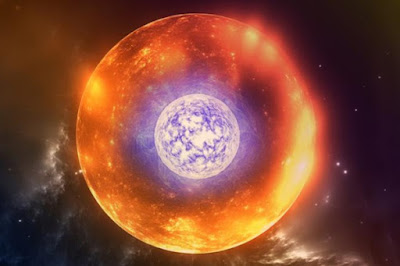Thorne-Zytkow Object: A Special Hybrid Star
In 1974, Polish astrophysicist Anna Zytkow and American physicist Kip Thorne proposed a very unique star. Their research included a special star that is formed when a neutron star is swallowed by a massive red supergiant. This special class of stars is known as the Thorne-Zytkow Object. For many, the theory is just a hypothesis as astronomers are still not sure if they have found any possible stars of this type. In their research paper published in 1975, Thorne and Zytkow suggested that the TZOs (Thorne-Zytkow Objects) will look much similar to a supergiant. The number of young, massive supergiants are very high in our universe. The TZOs would look very similar to a red supergiant, like Betelgeuse, located in constellation Orion. The only difference is that the TZOs are expected to survive 10 times longer than an ordinary red supergiant.
Reason for longer survival of the TZOs:
A neutron star is extremely dense compared to a normal star. Red supergiants are old, dying stars with the largest diameter of any star in the universe. Their diameters are about 200 to 2000 times wider than the Sun. A typical red supergiant is powered by nuclear fusion in its cores. Once the nuclear fusion in its core is stopped, it will slowly start to expand and will end as a supernova.
However, this is not in the case of the TZOs. As there is a neutron star at its core, the star no longer relies on nuclear fusion. The neutron star is itself highly compressed, so it will prevent the sudden gravitational collapse of the surrounding supergiant layers. This is the possible reason for the long existence of the TZOs.
 |
| Image Credit: Astronomy Magazine |
Properties of the TZOs:
Thorne-Zytkow Objects have their own set of unique properties. The average lifespan of a TZO is expected to be 10^5 to 10^6 years. This applies that there might be 200 possible TZO type stars in the Milky Way. The surface temperature of the TZO is also very high than a usual star. This is due to the strong gravitational compression by the neutron star.
As mentioned earlier, the TZO will look very similar to a red supergiant. However, it will produce heavy metals like yttrium, rubidium, zirconium, molybdenum and strontium at its core, which is not possible for a usual red supergiant. This process of formation of heavy metals at its core is due to Rapid Proton Bombardment. The core of a typical red supergiant is pure iron, with some amount of silicon and nitrogen.
Formation of the TZOs:
TZOs are one of the most unique star systems in the universe. Hence, the process of its formation is as unique as its properties. The binary stars usually revolve around each other. When red supergiants ran out of fuel, they begins to expand. They finally end up exploding into a supernova. This explosion gives birth to a neutron star. The core of a supernova is usually a neutron star. Imagine this happening in a binary star system. One of the two stars explodes into a supernova, while the second one continues to revolve. If the second star survives the explosion, then gradually it will start attracting the neutron star.
The attractive force will mostly act on the neutron star because of the size difference. A supergiant is about 200 times bigger than our sun and a neutron star is about the size of a city. So the neutron star easily gets attracted towards the supergiant.
Finally, a stage comes when the neutron star will merge into the supergiant without any explosion or disturbance. The merging of the two stars would happen very quietly. The neutron star will gradually make its way towards the core of the supergiant. This gives birth to a new type of star, the Thorne-Zytkow Object.
Searching a TZO:
Searching for a TZO is very complicated. As mentioned earlier, it resembles a red supergiant in almost all aspects. The only difference is the metal formation at its core. Astronomers use these metals as a way to search the TZOs. When the core of a red supergiant shows an excess of Lithium, Rubidium or Molybdenum, then it might be a possible candidate for the TZO.
One such possible star is discovered in our neighbour galaxy. After surveying around 62 red supergiants in the Small Magellanic Cloud (SMC), a dwarf galaxy around 200,000 light-years away from the Earth, a group of astronomers led by Emily Levesque identified HV 2112 as a possible TZO. At first sight, it looks like a typical red supergiant. But Levesque observed something unusual in that star. It was nothing but the excess of molybdenum and calcium at its core.
Another team of astronomers independently surveyed the HV 2112. This time they didn't find the same level of calcium or molybdenum. The new survey showed an excess of lithium at its core. It is only the excess of these metals at the core of HV 2112 which made astronomers include it under a possible TZO. All other properties of HV 2112 suggest that it is a normal red supergiant. However, many astronomers still consider HV 2112 as one of the best and nearest candidates of the TZO.
It is clear from the research of two different groups of astronomers that there is a lot more to do to practically prove the existence of the TZOs. Theoretically, we have defined them but till today we are unable to prove their practical existence.





Comments
Post a Comment
Please do not use foul language while commenting. We will appreciate your suggestions and reviews in the comments.